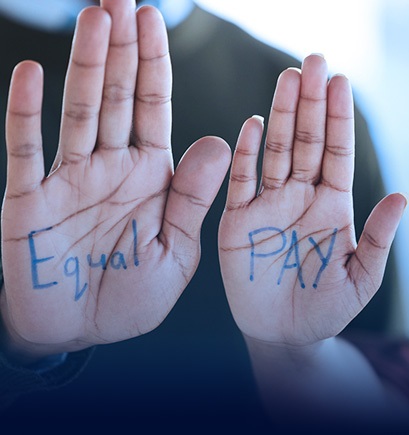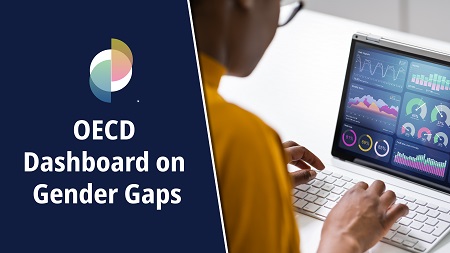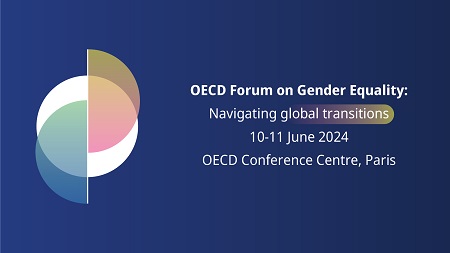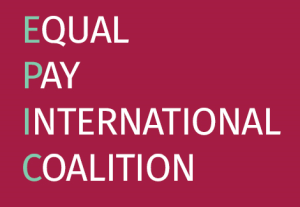The OECD Gender Initiative examines existing barriers to gender equality in education, employment, and entrepreneurship. This website monitors the progress made by governments to promote gender equality in both OECD and non- OECD countries and provides good practices based on analytical tools and reliable data.
OECD Dashboard on Gender Gaps
The OECD Gender Dashboard gives a snapshot of how a country’s gender equality policies and outcomes compare to that of other OECD countries across policy domains.
OECD Forum on Gender Equality
The 2024 OECD Forum on Gender Equality will address advancing gender equality amid green, energy, and digital transitions.
Report
Why OECD countries must step up efforts to boost gender equality
Despite progress in recent years, women and girls still face disadvantages and barriers in most spheres of social and economic life. OECD countries must do more – explore our latest publication.
This new publication analyses developments and policies for gender equality, such as gender mainstreaming and budgeting, reforms to increase fathers’ involvement in parental leave and childcare, pay transparency initiatives to tackle gender pay gaps, and systems to address gender-based violence. It extends the perspective on gender equality to include foreign direct investment, nuclear energy and transport.
Advancing gender equality is not just a moral imperative; in times of rapidly ageing populations, low fertility and multiple crises, it will strengthen future gender-equal economic growth and social cohesion.

Gender equality and work
Despite progress, women still fare worse than men in labour markets. Differences in employment rates, participation in part-time work, compensation and work quality lead to gender gaps in earnings and career advancement. This contributes to lower lifetime earnings and a greater risk of old-age poverty for women.
DISCOVER

Gender discrimination in social norms: Measuring the invisible
The discrimination embedded in social institutions – laws, social norms and practices – is a key driver of gender inequality, restricting the ability of women and girls to contribute to society and the economy. The OECD’s Social Institutions and Gender Index (SIGI) measures such gender discrimination across 179 countries.
DISCOVER

Gender mainstreaming in policymaking
Policies are not always neutral; gender bias may be hiding in government decision making, which risks exacerbating inequality and discrimination. Gender mainstreaming, a strategic approach that integrates a gender lens in policymaking, can help governments achieve more equitable outcomes. This can help boost public trust in governments, reinforce democratic institutions and combat gender stereotypes.
DISCOVER
Stat of the Month
Latest Info
- OECD Forum: Gender Equality: Navigating Global Transitions | 10-11 June 2024
- Conference: The future of girls in STE(A)M | 13-14 Dec. in Madrid
- Publication: Breaking the Cycle of Gender-based Violence | 2 Oct.
- Event replay: Policy Options to Better Value Women-Dominated Professions | 18 Sept.
- Publication: Gender equality in times of crisis: SIGI 2023 Global report | 18 July
- Publication: Reporting Gender Pay Gaps in OECD Countries - Guidance for Pay Transparency Implementation, Monitoring and Reform | 13 June
- Publication: Joining Forces : What is Holding us Back? | 9 May
- Publication: Supporting Lives Free from Intimate Partner Violence Towards Better Integration of Services for Victims/Survivors
- Data: U.S. Gender-data expansion project
- Focus: Same skills, different pay: Tackling Gender Inequalities at firm level
- Podcast: Don’t blame victims, focus on perpetrators: Making services work for domestic violence survivors
- Reports and data: Gender Equality in Latin America and the Caribbean
- See more documents
Key Documents
- Report on the Implementation of the OECD Gender Recommendations (June 2022)
- Gender Equality and the Empowerment of Women and Girls: : Guidance for Development Partners (May 2022)
- Tax Policy and Gender Equality: A Stocktake of Country Approaches (February 2022)
- Towards Improved Retirement Savings Outcomes for Women (March 2021)
- Changing Laws and Breaking Barriers for Women’s Economic Empowerment in Egypt, Jordan, Morocco and Tunisia (November 2020)
- Women at the core of the fight against the COVID-19 crisis (April 2020)
- The Pursuit of Gender Equality: An Uphill Battle (September 2017)
Equal Pay International Coalition (EPIC)
Led by ILO, UN Women and the OECD, the Equal Pay International Coalition (EPIC) is a multi-stakeholder coalition to contribute to the achievement of SDG target 8.5 focusing on equal pay between women and men for work of equal value [Short Video]







